MARIANI’S
Virtual
Gourmet
October 26,
2014
NEWSLETTER
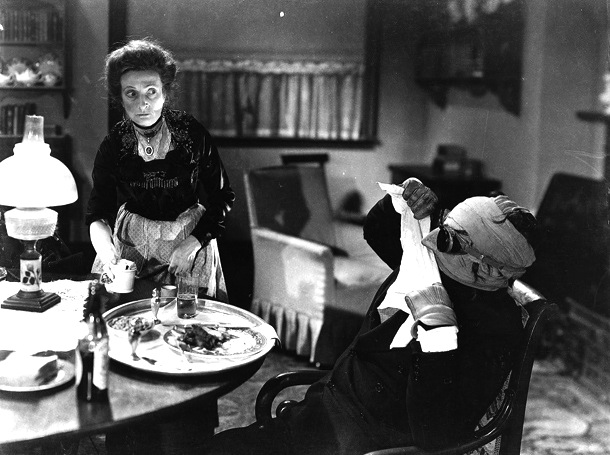
Una
O'Connor and Claude Rains in "The Invisible Man"
(1933)
HAPPY
HALLOWEEN!
IN THIS ISSUE
DRIVING THROUGH PUGLIA
By Brian Freedman
NEW YORK CORNER
Petaluma
By John Mariani
NOTES FROM THE WINE CELLAR
WINE TOURISM IN BORDEAUX
By John Mariani
❖❖❖
DRIVING THROUGH PUGLIA
By
Brian Freedman
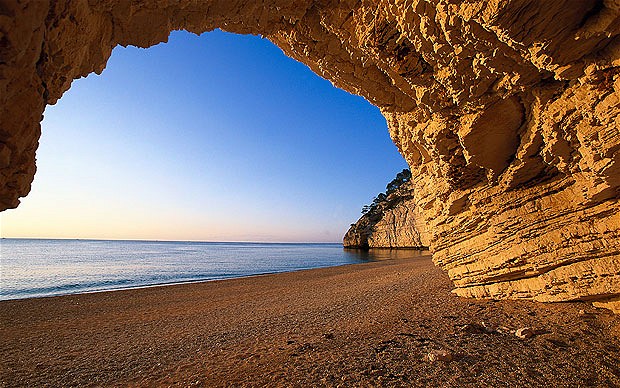
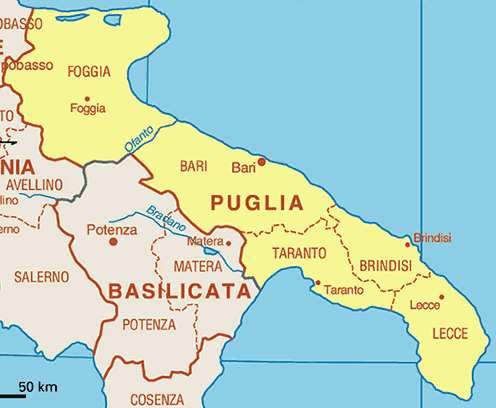 It
was, in the truest sense of the phrase, an offer I
couldn’t refuse. I had been
hired to host a wine lunch last October for
the National Italian American Foundation
during their gala weekend in Washington by my
friends and colleagues Patrizia Marin and
Valentino Viloni, who specialize in working
with Italian wine producers. After lunch,
Valentino asked me when I’d be in Italy next.
I had no idea, I told him, but I’d love to get
there soon.
It
was, in the truest sense of the phrase, an offer I
couldn’t refuse. I had been
hired to host a wine lunch last October for
the National Italian American Foundation
during their gala weekend in Washington by my
friends and colleagues Patrizia Marin and
Valentino Viloni, who specialize in working
with Italian wine producers. After lunch,
Valentino asked me when I’d be in Italy next.
I had no idea, I told him, but I’d love to get
there soon.
Before the end of that evening, I had agreed
to spend the month of June at his family’s summer
home in Puglia. Never mind that my wife was pregnant
with our second child and that we already had a
three-year-old girl. Never mind that we’d never been
to Puglia. Or that neither one of us spoke Italian.
The opportunity to spend a month in Italy was too
tempting for us to ever allow minor concerns like
work or normal grown-up responsibilities get in our
way.
It turned out to be one of the best decisions
my wife and I have ever made. The house, with
sweeping views of the Ionian Sea and stunning
beaches a quick walk from our front gate, was in the
town of Torre Colimena, a quiet seaside destination
for summering Italians from all over the country.
And while there wasn’t much going on when we arrived
on June 3rd--most of the shops and restaurants were
just starting to open 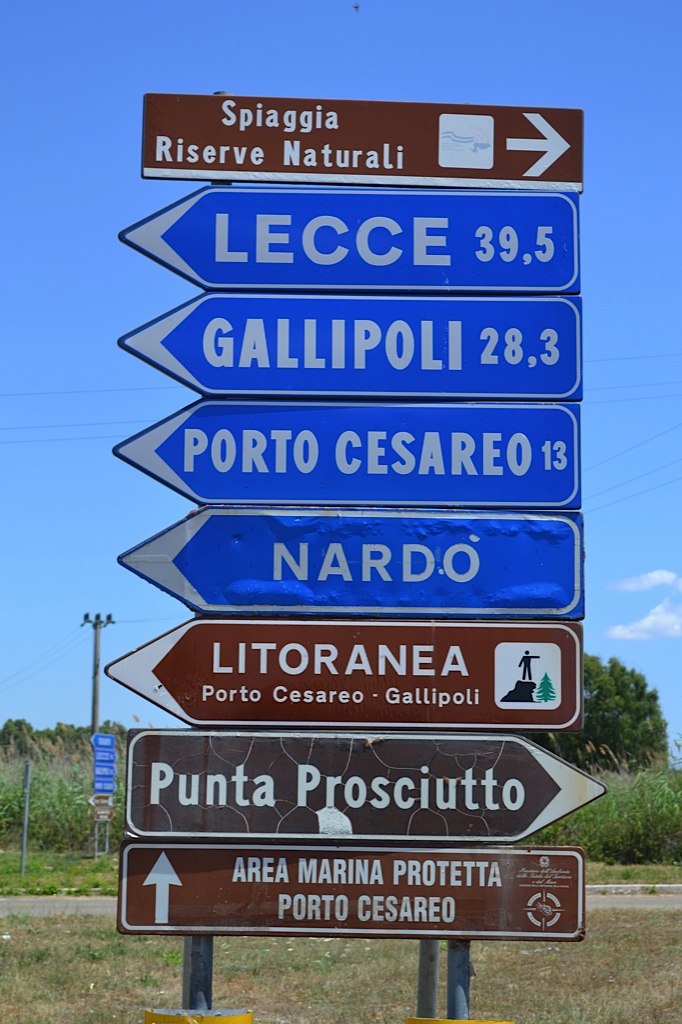 for
the season--the town was in full swing by the second
week, and from the Deja Vu
Café with its excellent espresso to the
Casa di Formaggio, from Ziu Belo
Pizzeria to Macelleria da
Enzo Fanuli and more, it proved to be an ideal
base from which to explore all that Puglia has to
offer. And
there is plenty of that, to be sure. Indeed, no
other region of Italy has garnered quite so much
adoring American press recently about its marked
uptick in popularity among travelers. And while the
more familiar Tuscany-Rome-Venice trifecta promises
to maintain their primacy among first-time visitors,
Puglia is bursting with its own unique charms, and
enough of them to make it a part of the country that
I strongly suspect will become a major international
destination in its own right.
for
the season--the town was in full swing by the second
week, and from the Deja Vu
Café with its excellent espresso to the
Casa di Formaggio, from Ziu Belo
Pizzeria to Macelleria da
Enzo Fanuli and more, it proved to be an ideal
base from which to explore all that Puglia has to
offer. And
there is plenty of that, to be sure. Indeed, no
other region of Italy has garnered quite so much
adoring American press recently about its marked
uptick in popularity among travelers. And while the
more familiar Tuscany-Rome-Venice trifecta promises
to maintain their primacy among first-time visitors,
Puglia is bursting with its own unique charms, and
enough of them to make it a part of the country that
I strongly suspect will become a major international
destination in its own right.
The food and the wine
are major contributors to its appeal. And while the
great local grape varieties are perhaps less
familiar to American consumers, Primitivo and
Negroamaro promise to gain in popularity once they
become better known. The spice and friendly fruit of
the former and the depth and richness of the latter
are well suited to the American palate and
phenomenal, whether vinified as reds or rosati,
with Puglian food.
The Negroamaro
Wine Festival, held annually in the bustling city of
Brindisi, is occasion enough to warrant planning a
trip to Puglia around its schedule, spread out over
a week in June. Much of the city center is
transformed into a huge open-air gala, replete with
wine and food stands on the sidewalks, music and
activities, and even, this past year, a performance
by Kool and the Gang to wrap it all up.
In addition to Brindisi, make sure to visit
Lecce, a city of nearly 100,000 residents that, with
its museums, exceptionally urbane vibe and excellent
restaurants, more than earns its nickname, the
Florence of the South. Over the course of our month
in Puglia, we ventured there three separate times,
and each resulted in the discovery of another side
of this exceptionally beautiful and friendly city.
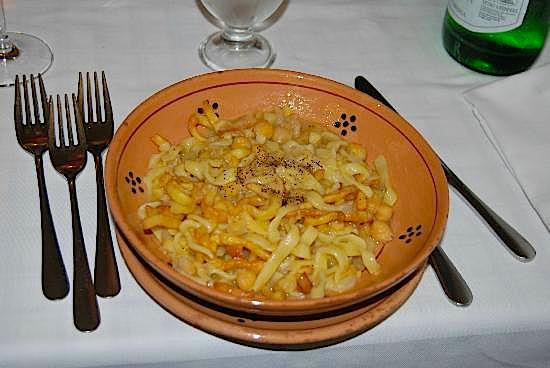 Alle Due
Corti provided
one of our most memorable meals. The restaurant
features the classics of the region prepared with
the careful technique of a highly accomplished chef,
and the result is stunning. Ciceri e trio
(left), a dish composed of boiled and fried
pasta whose sauce is thickened with the starch from
cooked chickpeas, is a prime example of the heights
that the cuisine here can achieve.
Alle Due
Corti provided
one of our most memorable meals. The restaurant
features the classics of the region prepared with
the careful technique of a highly accomplished chef,
and the result is stunning. Ciceri e trio
(left), a dish composed of boiled and fried
pasta whose sauce is thickened with the starch from
cooked chickpeas, is a prime example of the heights
that the cuisine here can achieve.
Doppiozero is not only known as home to one of
the great bars of the country, but also features a
menu that modernizes Puglian food without losing its
soul. All’Ombra
dell Barocco allows guests to enjoy their meal
either inside, beneath stone arches, or outside in
the cafe. We opted for the café--it was warm
and sunny, as it was most of the time in June--and
we were not disappointed. Frisa leccese
multicereali, like a bruschetta on steroids
but built on a base of rehydrated dried multigrain
bread, is worth the trip by itself, as is so much of
the rest of the menu. And, since this is Italy, no
meal--or moment, for that matter--is complete
without a scoop or three of gelato. Crem, a
cheery Lecce storefront, is home to some of the best
we tasted the entire month.
Time
and again, we found ourselves stunned to silence by
a particularly wonderful bite of food. At Panificio Due
Emme in the lovely town of Laterza, hearty,
deeply soulful breads are baked the old-fashioned
way (right): A fire is built in a stone
hearth with wood, olive-tree clippings, and, when in
season, apricot stones and almond shells, allowed to
burn until it consumes itself, and then the ashes
are swept out. Doughs 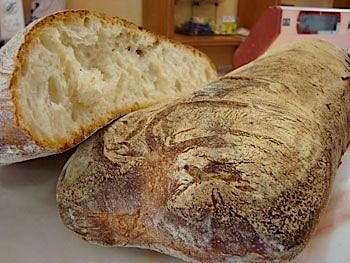 are then placed right on the
scorching stone, and the ambient heat of the oven
cooks it all through. The result is a bread so
hearty, so protected by its thick crust, that you
can let it sit on the counter for a week before
cutting into it without losing any of its texture.
Not that you’d want to, of course. The aroma alone
guarantees that you’ll tuck into it before you even
get home. Or, rather, before you leave the shop.
are then placed right on the
scorching stone, and the ambient heat of the oven
cooks it all through. The result is a bread so
hearty, so protected by its thick crust, that you
can let it sit on the counter for a week before
cutting into it without losing any of its texture.
Not that you’d want to, of course. The aroma alone
guarantees that you’ll tuck into it before you even
get home. Or, rather, before you leave the shop.
Laterza
in
its entirety is an excellent destination. Thanks to
my new friend Monica Caradonna of Cantine
Due Palme, we were fortunate enough to spend a
day in Laterza with her, Mayor Gianfranco Lopane,
and a phenomenal entourage, including Silvana
Caldarazza, a translator who also rendered into
English the book “Like A Song of Beauty…,” about the
beautiful Santuario Mater Domini in Laterza.
Naturalists will adore La Gravina di Laterza
, a sweeping gorge lovingly referred to as the Grand
Canyon of Italy; foodies will swoon over the magic
woven in the kitchen at Trattoria
del Purgatorio--the polpette
were among the best I’ve tasted, and chicorelle con
fave bianche, one of many memorable chicory
dishes we enjoyed in Puglia, was transporting. Art
lovers should make a visit for the famous
blue-and-white ceramics that are perfected here at
venues like SuMo Maioliche d’Arte, the level
of detail breathtaking; and the Piazza Spagnola, a
hidden gem of frescoes hundreds of years old.
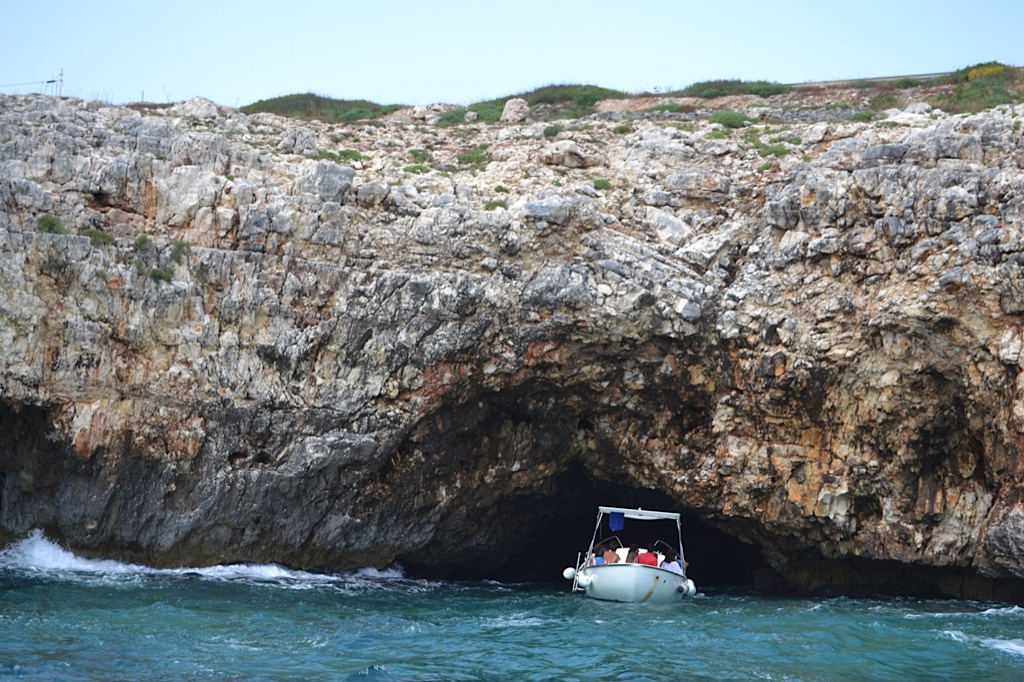 Located
in
the heel of the Italian boot, Puglia boasts
countless beaches and beachfront communities,
seemingly all of them pedestrian friendly and lined
with cafés and restaurants specializing
in the sort of seafood that this part of Italy is
famous for. Santa Maria di Leuca (left), the
very bottom of the heel, is a breathtaking seascape
with gorgeous grottoes that are easily visited by
booking an inexpensive ticket (15 euros for adults)
on one of the tour boats that leave the port
regularly.
Located
in
the heel of the Italian boot, Puglia boasts
countless beaches and beachfront communities,
seemingly all of them pedestrian friendly and lined
with cafés and restaurants specializing
in the sort of seafood that this part of Italy is
famous for. Santa Maria di Leuca (left), the
very bottom of the heel, is a breathtaking seascape
with gorgeous grottoes that are easily visited by
booking an inexpensive ticket (15 euros for adults)
on one of the tour boats that leave the port
regularly.
If you do venture there and want to stay
overnight, consider Villa Arditi, an
agriturismo run by Francesco Arditi of a noble
family. He is a young man of ambition and vision,
and the work he has done transforming his family’s
villa and grounds in nearby Presicce is remarkable.
Further north in Puglia, towns like
Gallipoli, Porto Cesareo, Ostuni, Otranto, and more
are absolutely worth seeking out. And the good news
is that the magnificent seafood of the region is
available everywhere. Osteria Sud e
Terre Lontane in Avetrana, for example,
prepared a dish I still dream about months
later: spaghetti glistening with a crab-infused
tomato sauce. Accompanied by some of the great local
olive oil and washed down with a carafe of rosato,
it’s pretty much perfect.
As for that olive oil, it is more or less
guaranteed to ruin you forever. I have spent
every day since returning to Philadelphia as an
insufferable olive oil snob, glaring hatefully at
the oversized bottle of Bertoli on our kitchen
counter. It’s just what happens when you get so
spoiled with the good Puglian oils.
Olive trees cover a significant portion of
the land here. As you drive along at dusk, the
sunlight slashes against the silvery leaves of the
olive trees (right) and casts the entire
landscape into a distinctly silver-toned glow. And
the olive oil itself is amazing. Producers like Masseria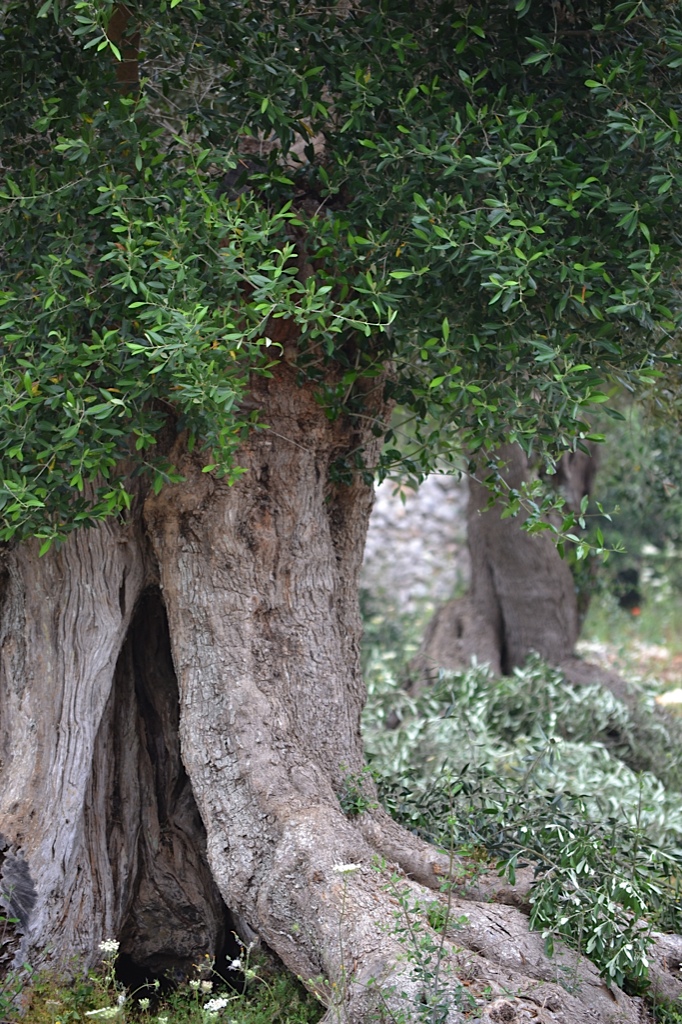 Guidara and L’Acropoli di
Oliva are crafting extra virgin olive oils as
profound as the most accomplished wines. Le Ferre
has won me over with its particularly delicious
infused olive oils. Interestingly, you’re generally
not offered olive oil to dip your bread into, and it
was only at L’Acropli di Oliva that it was explained
why: Because the local bread, so hearty and full of
character itself, will overwhelm the oil, which is
better suited to anointing more delicate dishes
instead.
Guidara and L’Acropoli di
Oliva are crafting extra virgin olive oils as
profound as the most accomplished wines. Le Ferre
has won me over with its particularly delicious
infused olive oils. Interestingly, you’re generally
not offered olive oil to dip your bread into, and it
was only at L’Acropli di Oliva that it was explained
why: Because the local bread, so hearty and full of
character itself, will overwhelm the oil, which is
better suited to anointing more delicate dishes
instead.
The wines of the region are every bit as
delicious, and I’ve rarely had so many great wines
for such fair prices. The local markets sell nice
bottles for around $7 each, and if you want to go
just a bit higher, you can really taste something
special. Over the course of our stay in Puglia, I
toured and tasted at Cantine Due
Palme,
Cantele, Masseria Li Veli, and Gianfranco
Fino, all of which were spectacular. From
value-priced bottles to pricier ones that have been
garnered with awards all over the world, they embody
exactly what makes Puglian wine so special, as does
the Cantine Risveglio “72100” Negroamaro:
expressiveness, terroir specificity, and food
friendliness, as well as a sense of exuberance that
demands a second glass, and then a third,
let’s be honest here, a fourth, as long as you’re
not driving.
At the
end of each day, it was nothing short of magic to
drive back to our home in Torre Colimena, and every
time we came through the roundabout in our little
Fiat Panda and glimpsed the sea stretching out in
front of us, and listened to the whisper of the
olive trees as we sped on past, we were washed over
by a perhaps paradoxical sense of calm and
excitement: We were home, and giddy to be able to
call this home for an entire month.
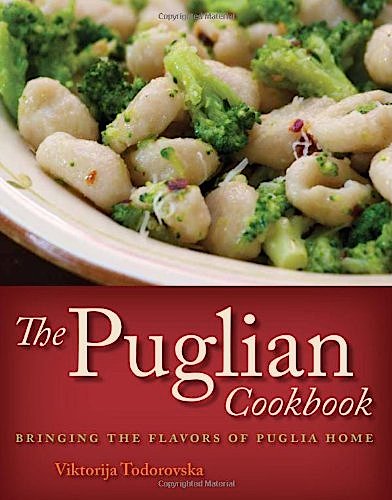 For
a very good insight and authentic recipes for
Puglian cuisine, The Puglian
Cookbook by
Viktorija Todorovska (whose The
Sardinian Cookbook
was a finalist for an IACP award last year) is
an excellent resource.--John Mariani
For
a very good insight and authentic recipes for
Puglian cuisine, The Puglian
Cookbook by
Viktorija Todorovska (whose The
Sardinian Cookbook
was a finalist for an IACP award last year) is
an excellent resource.--John Mariani❖❖❖
NEW YORK CORNER
By John Mariani
PETALUMA
1356 1st Avenue (near 73rd Street)
212-772-8800
petalumarestaurant.com
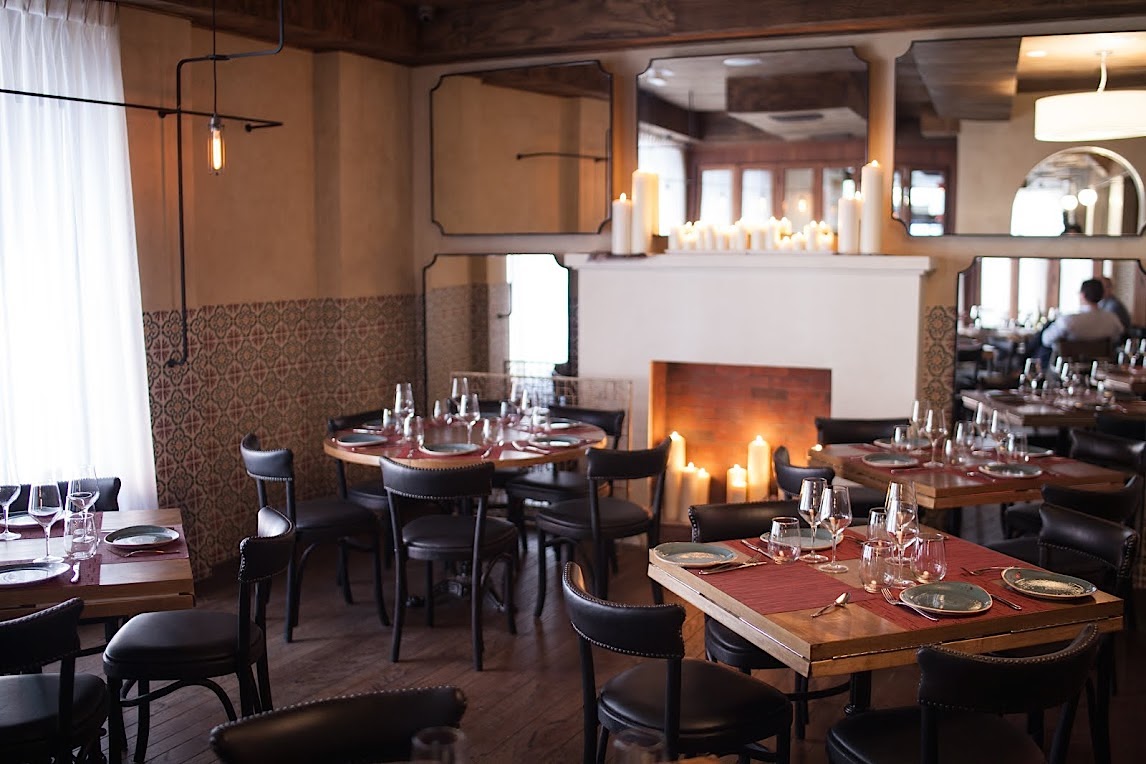
For
three decades Petaluma in the Yorkville
section of Manhattan’s Upper East Side was a
dependable, consistent, and always very
popular neighborhood Mediterranean restaurant
with a name derived from a city in California. Back
then California cuisine was all the rage, and
the restaurant had the open kitchen requisite
at the time.
After being
closed for a couple of years, the space was bought
and redecorated this past summer by the Line
Group, which also operates Sons of Essex and The
Raven. They
kept the original name, and people responded
favorably from the day it re-opened.
The room still
has the lineaments of the original, spruced up
now, with a front café and bar with
high-top tables and a main dining area done with
leather banquettes, patterned tile work, bare
tables, a wall of mirrors, and a fireplace set
with tall glowing candles; the kitchen has been
completely recast with marble countertops.
The owners have brought in
Executive Chef C.J. Bivona, who formerly worked at
Miami’s acclaimed Yard Bird Southern Table &
Grill, and his preference for gutsy, hearty,
full-flavored Italian food is evidenced in every
corner of the menu.
There are a lot of standard dishes everyone
expects in this neck of the woods, and with the
wood-fired pizzas and a roaring rotisserie, the
kitchen is put the test at peak hours, though the
wait staff tries mightily to keep up.
I ordered a pizza with fried
eggplant, mozzarella and basil ($19), and its
crust was both pliant and crisp, the sweet
eggplant melding 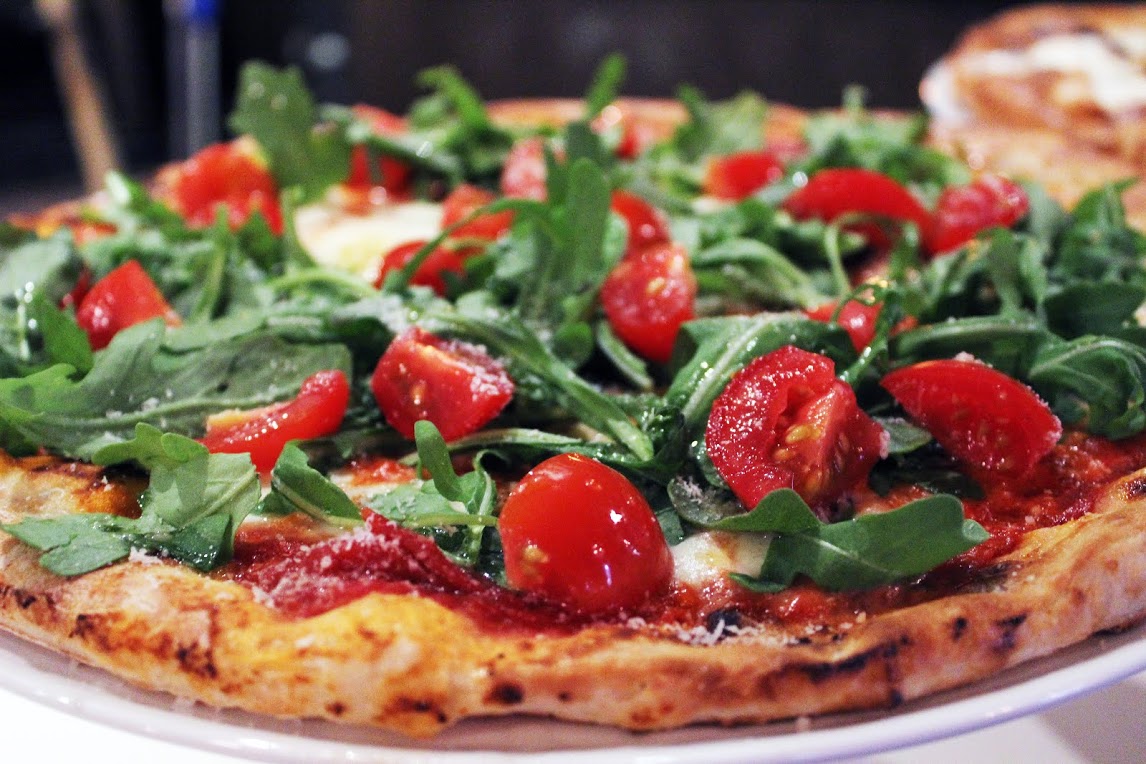 well with
the fresh cheese.
well with
the fresh cheese.
All the pastas are housemade,
which makes them easy to under- or overcook. Sadly,
some seem to sit a little long in the kitchen and
may be tepid upon arrival at the table. The
best, however, was a terrific take on classic
spaghetti carbonara
($19), here made with chubby Asian udon
noodles, poached egg, peas, and black pepper (below) well
married in a luscious novel way. Also
excellent was a beautifully cooked, tender
risotto—there’s a different one each day at market
price. Nonna’s Fried Pasta, made from pan-seared
angel’s hair pasta with meatballs, was a pleasing,
homey recipe that in fact was based on that of
Bivona’s own grandmother.
Gnocchi “Bolognese” ($23) was compromised
by being both lukewarm, and, though the menu
indicated it was cooked with “manzo
croccante” (crispy beef), the potato dough
dumplings themselves were chewy and tough.
I was impressed with every one
of the main courses I tried, beginning with an
impeccably cooked branzino, roasted whole on the bone,
served with bitter greens and charred lemon
(market price), each element ideal for bringing
out the flavors of the meaty fish. One
could hardly improve on the roasted 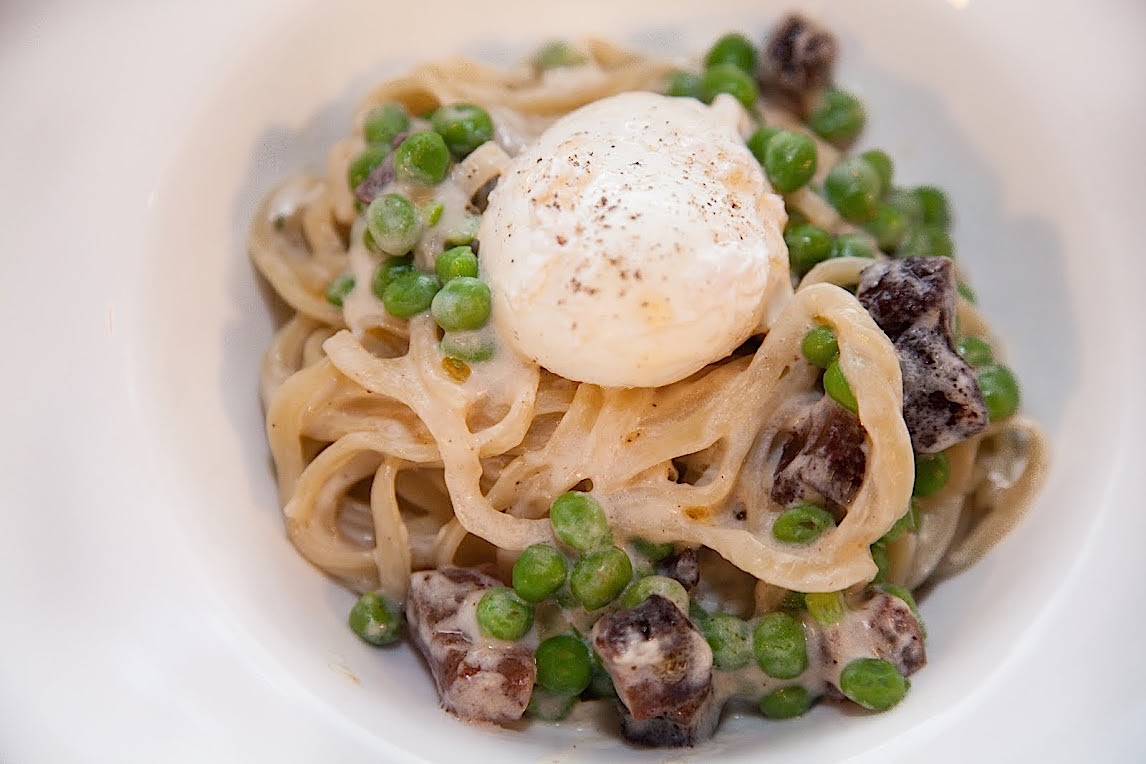 chicken
with a roasted tomato chimichurri ($26)
and rich garlic jus, and
a churrasco skirt steak with more chimichurri
($26) had the right chewiness and an
eyebrow-raising heat. Porchetta,
now become somewhat trendy in New York, is often
dry and made too far in advance, but at Petaluma,
the kitchen handles this rolled pig, with
succotash, charred scallions and a fine romesco
sauce ($29), with great aplomb, the skin
crackling, the thickness of inner fat intact, and
the meat truly juicy.
chicken
with a roasted tomato chimichurri ($26)
and rich garlic jus, and
a churrasco skirt steak with more chimichurri
($26) had the right chewiness and an
eyebrow-raising heat. Porchetta,
now become somewhat trendy in New York, is often
dry and made too far in advance, but at Petaluma,
the kitchen handles this rolled pig, with
succotash, charred scallions and a fine romesco
sauce ($29), with great aplomb, the skin
crackling, the thickness of inner fat intact, and
the meat truly juicy.
By all means share a
dessert—perhaps the very good warm chocolate cake
or the affogato
of gelato with unsweetened espresso poured over
it. The
sorbetti
here are really intense and served at just the
right texture.
There’s also a Nutella chocolate pizza
offered ($12).
The wine list has a judicious
75 labels, just right for this size restaurant,
with 20 available by the glass. Most
are Italian but some are Italian varietals made in
California.
Which in a way brings Petaluma
full circle, drawing on a creditable history of
how Italian food in this country was in fact
improved back in the ‘80s by California culinary
techniques.
It’s as if the doors had never really
closed.
Petaluma
is located at 1356 1st Avenue (near 73rd Street);
212-772-8800; Open for lunch and dinner daily,
brunch on weekends; A four-course meal is
offered at $64.
❖❖❖
NOTES FROM THE WINE CELLAR
WINE TOURISM IN BORDEAUX
By John Mariani
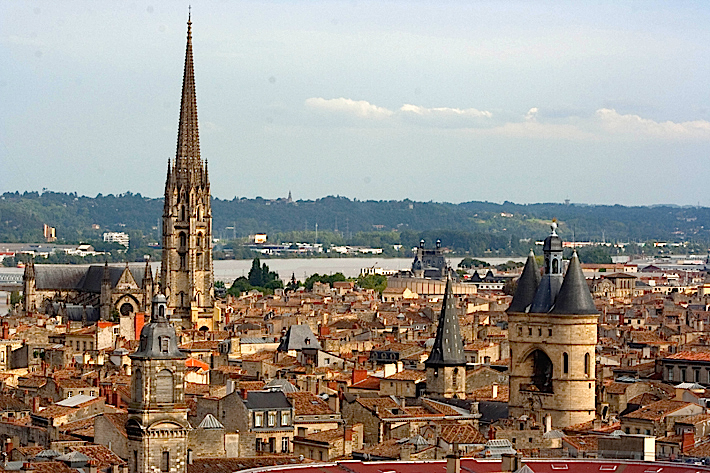
Do
not look for mountains or valleys in Bordeaux. Do
not look for rich red earth or vast forests. And don’t
look for spa resorts with Olympic-size swimming
pools and cabanas.
That may be all well and good for Napa Valley
or the hills of Tuscany or the stunning mountains
along the Rhine, but Bordeaux has its own virtues:
castles and chateaux of great beauty, impeccably
maintained vineyards on gravelly soil, and some
superb restaurants.
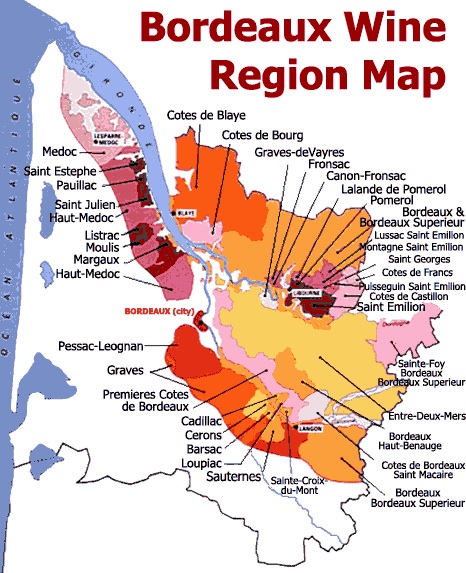 The
fact that you can easily arrange to visit the great
wine estates of Bordeaux while staying in some
sumptuous nearby hotels makes this area of southwest
France one of the most soul- and appetite-satisfying
vineyard regions in the world. Indeed,
most chateaux are open to the public, as long as you
write ahead. (To obtain names and addresses, contact
the Bordeaux Wine Bureau in NYC; 212-477-9800.)
The
fact that you can easily arrange to visit the great
wine estates of Bordeaux while staying in some
sumptuous nearby hotels makes this area of southwest
France one of the most soul- and appetite-satisfying
vineyard regions in the world. Indeed,
most chateaux are open to the public, as long as you
write ahead. (To obtain names and addresses, contact
the Bordeaux Wine Bureau in NYC; 212-477-9800.)
It
is a huge area of more than 280,000 acres of
vineyards, with 22,000 vineyard proprietors and
7,000 châteaux, or domaines,
producing 800 million bottles of wine
annually—compared with less than 36 million produced
in the far smaller region of Burgundy. Way back
in 1855 the wine merchants of Bordeaux created a
classification of the region’s very finest estates
of the Médoc, Sauternes, and Barsac regions,
based on the consistently high prices their wines
sold for over the decades. These were broken down into
quality categories called “crus”
(growths), which in Bordeaux referred to an estate.
Thus, there were Premier Crus
(First Growths), Deuxièmes
Crus (Second Growths), and on down to Cinquièmes
Crus (Fifth Growths). The wines of Graves and
St. Émilion were also classified; those of
Pomerol and other regions were not. One St.
Émilion wine, Château Haut-Brion, was
listed under the Premier Cru
appellation. In
1973, one wine of the Médoc, Château
Mouton-Rothschild, was awarded First Growth status,
but no other estate has succeeded in elevating its
status since 1855.
Many
of the classified crus are
set on exquisite properties, usually home to their
proprietors, with glorious manicured lawns and
pebbly walkways leading to clear-cut vineyards
ringed with roses. (If a pestilence is about to hit
the vineyards, roses will catch it first and give
the vineyard workers advance notice). 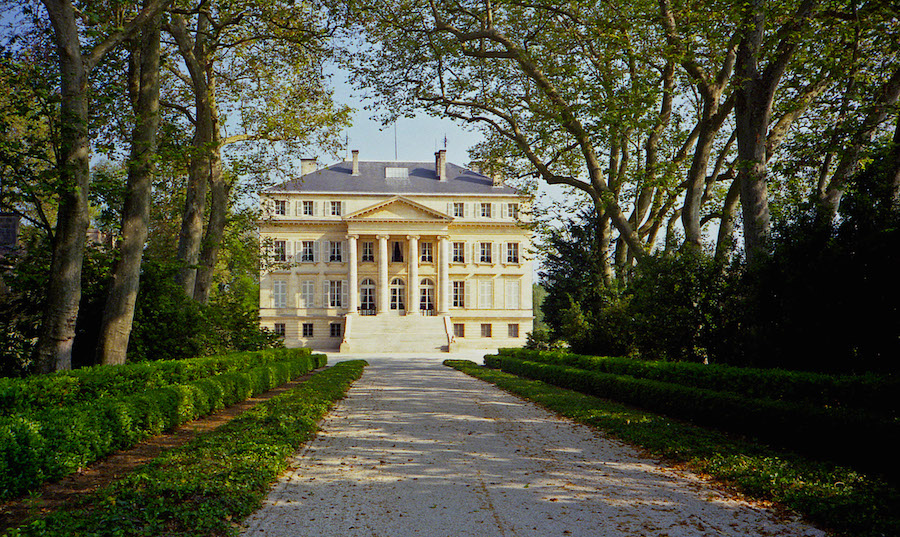 Château
Margaux (right), for instance,
is a butter-yellow 1810 Neo-Palladian edifice
designed by architect Louis Combes for the Marquis
de la Colonilla. It has been called “The Versailles
of the Médoc” and since 1946 has been listed
as an “historic monument” of France.
Château
Margaux (right), for instance,
is a butter-yellow 1810 Neo-Palladian edifice
designed by architect Louis Combes for the Marquis
de la Colonilla. It has been called “The Versailles
of the Médoc” and since 1946 has been listed
as an “historic monument” of France.
The side effect is that visitors to the
region are welcomed with open arms, by both the
restaurants and the estates, which wouldn’t mind at
all if you go home with several cases of their
wines. At
Château Giscours (a Third Growth), which dates
back to the 14th
century, you may not only visit, you may also dine
in their splendid restaurant with the estate’s
enologist, who will explain the wines you are
drinking. There
are also beautiful banquet rooms available for
meetings and receptions.
The region, cut through by the Gironde River,
which irrigates all the vineyards, also has some
lovely places to stay while visiting the wineries. The city
of Bordeaux has become a much livelier place than it
used to be, now with 15 museums, including the
Bordeaux Wine Museum, and beautiful squares and
mansions that date back to the time 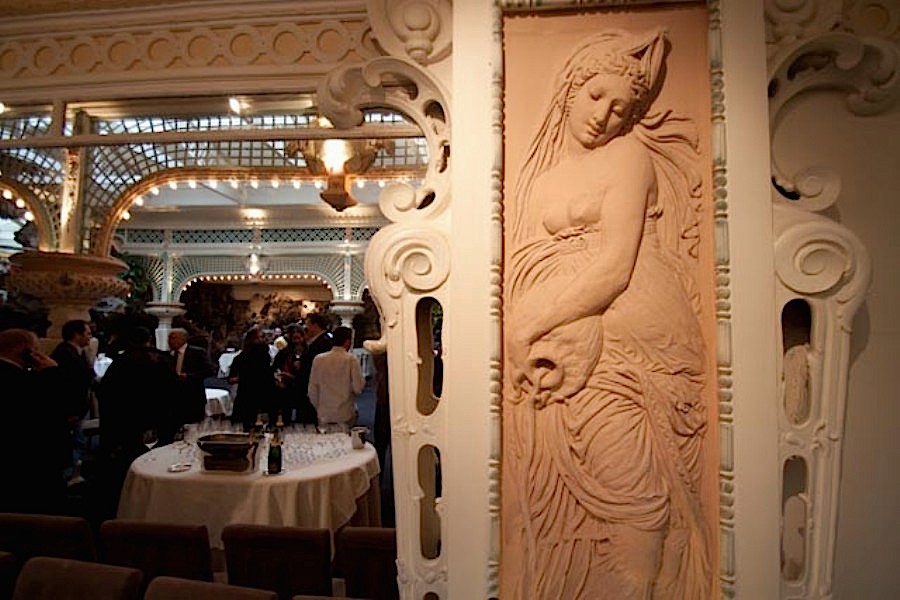 of
Victor Hugo, who was a member of the National
Assembly here.
of
Victor Hugo, who was a member of the National
Assembly here.
The city has many fine
restaurants—including three with Michelin stars. Le Chapon Fin
(left), with its fanciful
fin-de-siècle décor, opened in 1823
and still keeps a classic Bordelais menu, with
plenty of foie gras, roast squab, and a renowned
roast lamb with sage butter. In warm
weather take a table on the terrace of the more
modern Pavillon
des Boulevard, known for its delicious
lobster in chestnut cream. And the small, intimate Jean
Ramet, on the river’s bank, is always populated with
estate owners and merchants who come for the
namesake chef’s refined regional cooking, like foie
gras with candied dates and orange. For something
more casual, the rustic bistro Tupiña cooks
many of its dishes over an open fire fueled by grape
vines.
In
the village of Pauillac there is the spectacular 17th
century Château
Cordeillan Bages (below), once a
Carthusian monastery, with 25 rooms and 4 suites,
and a Michelin two-star restaurant that serves
cuisine of great finesse, from eggplant marinated in
olive oil with langoustines with lemon-thyme, and
rack of lamb with a fricassée of vegetables.
In St. Émilion the place to stay is the Hostellerie
de Plaisance, restored to pristine 18th
century grandeur.
Château
Cordeillan Bages (below), once a
Carthusian monastery, with 25 rooms and 4 suites,
and a Michelin two-star restaurant that serves
cuisine of great finesse, from eggplant marinated in
olive oil with langoustines with lemon-thyme, and
rack of lamb with a fricassée of vegetables.
In St. Émilion the place to stay is the Hostellerie
de Plaisance, restored to pristine 18th
century grandeur.
With
7,000 châteaux to see, visiting Bordeaux may
take a while.
But the pleasures of visiting once can only
serve to bring you back again, wondering what
wonderful wine you may have missed and what charming
chateaux you haven’t seen.
❖❖❖
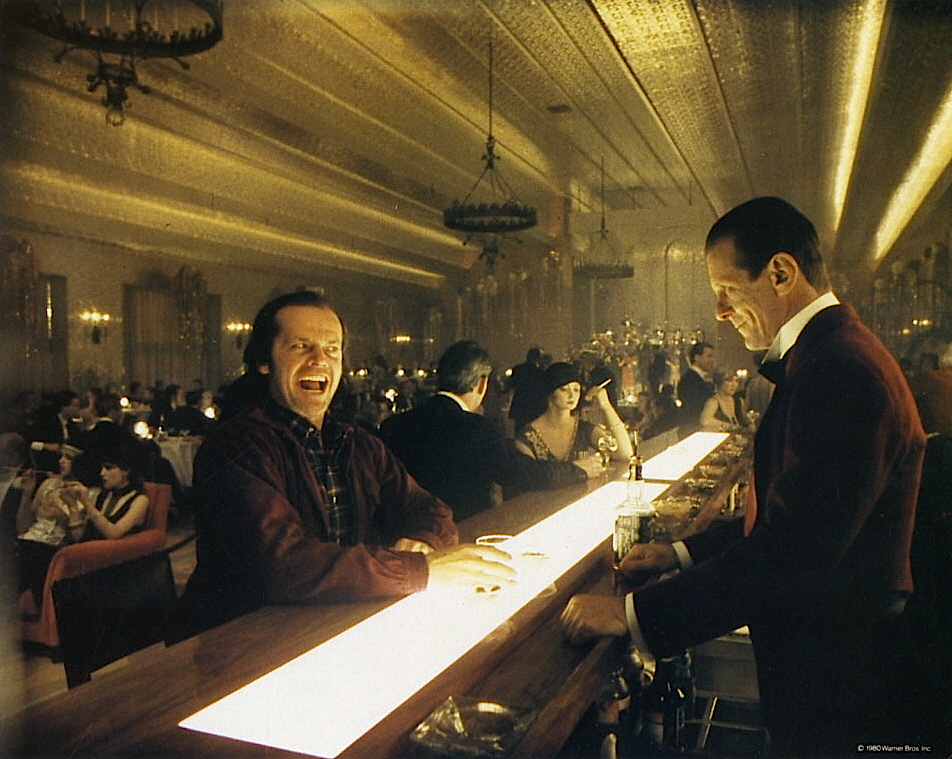
WRETCHED
EXCESS NO. 45,887
In
D.C., at Second State restaurant the ice cubes are
"handcrafted,"
so if you want your cocktail on the rocks,
that will
cost you $1 extra.

❖❖❖
WINE TRICKS AND TREATS

by Cristina Mariani-May
co-CEO of Banfi
Vintners America's leading wine importer
Halloween
is
almost here! Whether
you will be dressing up or dressing down this year,
ringing doorbells or answering them, leave most of the
candy for the kids but make sure you have your own
tricks and treats on hand.
Inevitably, there will be candy
around the house, be it from your own
trick-or-treaters, leftovers from the unpredictable
costumed traffic at the front door, or the ambitiously
planned Halloween party. When it comes to the usual
assortment of treats, savory or sweet, don’t forget
the basics of wine pairing! You will want to have some
matches that highlight contrasting flavors, others
that bring two similar qualities together to intensify
a flavor. Here
are some fun wines to consider:
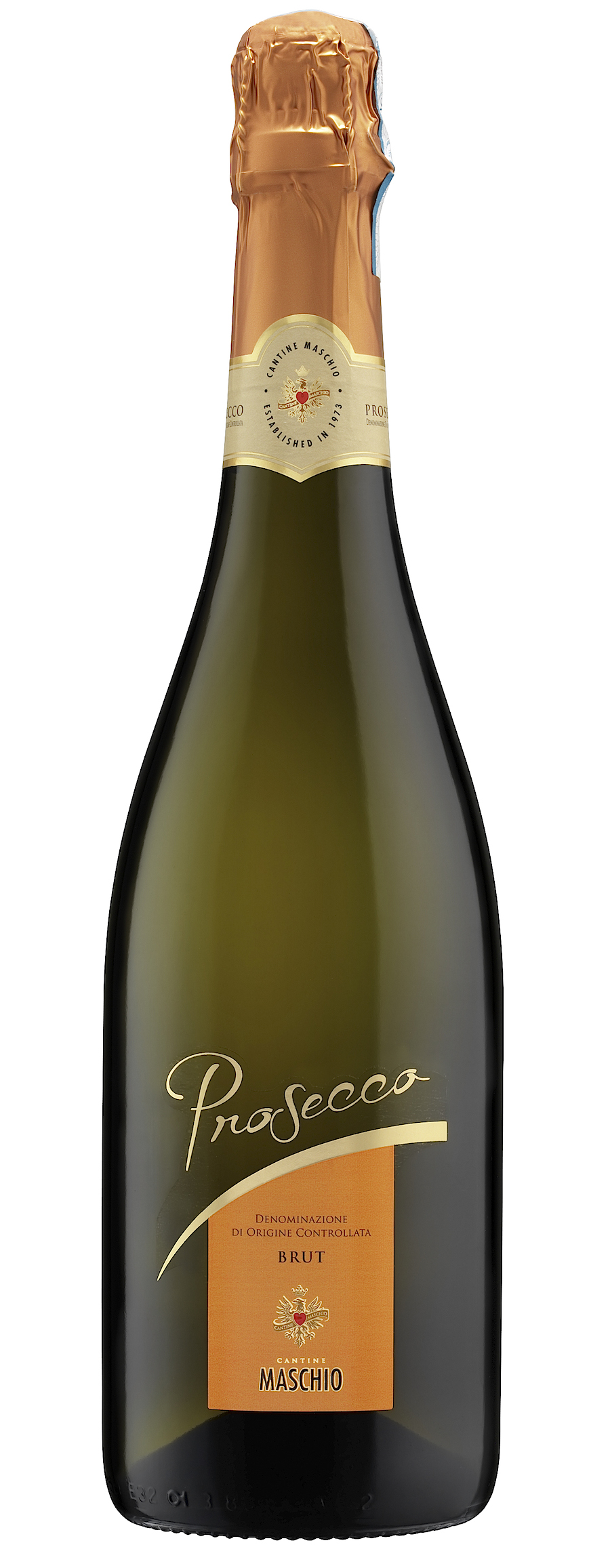 Maschio Prosecco Brut (left)
is a great all-around choice to have on hand – a
delightful, crisp, gently sparkling wine, this will
help refresh the palate worn on anything from
Twizzlers to candy corn. Will go nicely with salted
popcorn and pretzels too!
Maschio Prosecco Brut (left)
is a great all-around choice to have on hand – a
delightful, crisp, gently sparkling wine, this will
help refresh the palate worn on anything from
Twizzlers to candy corn. Will go nicely with salted
popcorn and pretzels too!
Pacific
Rim “Solstice Vineyard” Riesling has a wonderful dry feel, with a hint
of tangerine on the finish after a nice hit of peach,
apple and floral flavors. Could be an interesting match to
the rainbow flavor of Chuckles candies, or contrast to
the coconut intensity of Mounds bars and Almond Joy.
Luna
Mater Frascati Superiore (right)
will go great with caramel flavors of butterscotch
candies and toffee, such as Mary Janes, Twix, and even
Butterfingers. You
can also enjoy this with savories such as grilled
salmon or fried chicken for dinner.
I
Saltari Amarone is
a great example of the juicy flavors of Verona’s
classic wine made from carefully dried grapes, almost
raisiny in character.
Its berry and jammy flavors are balanced by
hints of spice that will make it click with classics
like Snickers, Kit Kats, and Nestle Crunch. It will
also go quite well with barbecued
steak or burgers.
And if you want to send your adult
trick-or-treaters home with an appropriate treat of
their own, consider filling their goody bags with one
or two 187ml single-serve bottles. You can
find these cuties from any of the following, usually
sold in 4-bottle carry packs:
Riunite
Lambrusco, Bianco, Rosato, D’Oro and
other flavors.
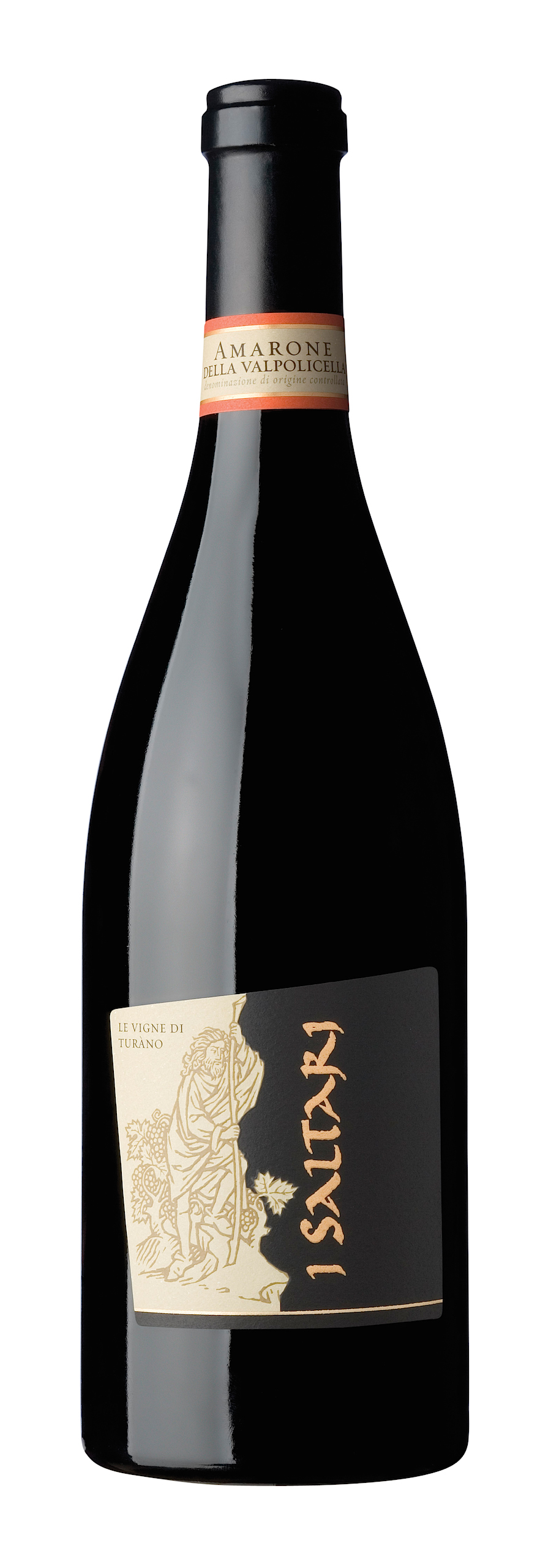 Bolla Valpolicella, Soave, Chianti, Pinot
Grigio and Merlot.
Bolla Valpolicella, Soave, Chianti, Pinot
Grigio and Merlot.
Walnut
Crest Cabernet Sauvignon, Merlot,
Chardonnay and Sauvignon Blanc.
Rosa
Regale in the same pretty decanter bottle
as the full size package, and an outrageous match to
anything made with dark chocolate!
Whichever treats you choose, have a
happy and safe Halloween.
A BIG ANNOUNCEMENT!

I'm proud and happy to announce that my new book, The Hound in Heaven (21st Century Lion Books), has just been published through Amazon and Kindle. It is a Christmas novella, and for anyone who loves dogs, Christmas, romance, inspiration, even the supernatural, I hope you'll find this to be a treasured favorite. The story concerns how, after a New England teacher, his wife and their two daughters adopt a stray puppy found in their barn in northern Maine, their lives seem full of promise. But when tragedy strikes, their wonderful dog Lazarus and the spirit of Christmas are the only things that may bring back his master back from the edge of despair.
“What a huge surprise turn this story took! I was completely stunned! I truly enjoyed this book and its message.” – Actress Ali MacGraw
“He had me at Page One. The amount of heart, human insight, soul searching, and deft literary strength that John Mariani pours into this airtight novella is vertigo-inducing. Perhaps ‘wow’ would be the best comment.” – James Dalessandro, author of Bohemian Heart and 1906.
“John Mariani’s Hound in Heaven starts with a well-painted portrayal of an American family, along with the requisite dog. A surprise event flips the action of the novel and captures us for a voyage leading to a hopeful and heart-warming message. A page turning, one sitting read, it’s the perfect antidote for the winter and promotion of holiday celebration.” – Ann Pearlman, author of The Christmas Cookie Club and A Gift for my Sister.
“John Mariani’s concise, achingly beautiful novella pulls a literary rabbit out of a hat – a mash-up of the cosmic and the intimate, the tragic and the heart-warming – a Christmas tale for all ages, and all faiths. Read it to your children, read it to yourself… but read it. Early and often. Highly recommended.” – Jay Bonansinga, New York Times bestselling author of Pinkerton’s War, The Sinking of The Eastland, and The Walking Dead: The Road To Woodbury.
“Amazing things happen when you open your heart to an animal. The Hound in Heaven delivers a powerful story of healing that is forged in the spiritual relationship between a man and his best friend. The book brings a message of hope that can enrich our images of family, love, and loss.” – Dr. Barbara Royal, author of The Royal Treatment.
Any of John Mariani's books below may be ordered from amazon.com.
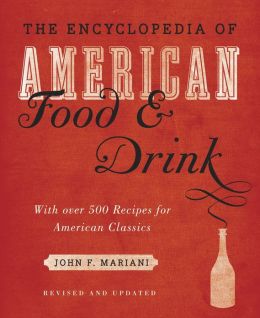 |
The Encyclopedia of American Food and Drink by John F. Mariani (Bloomsbury USA, $35) Modesty forbids me to praise my own new book, but let me proudly say that it is an extensive revision of the 4th edition that appeared more than a decade ago, before locavores, molecular cuisine, modernist cuisine, the Food Network and so much more, now included. Word origins have been completely updated, as have per capita consumption and production stats. Most important, for the first time since publication in the 1980s, the book includes more than 100 biographies of Americans who have changed the way we cook, eat and drink -- from Fannie Farmer and Julia Child to Robert Mondavi and Thomas Keller. "This book is amazing! It has entries for everything from `abalone' to `zwieback,' plus more than 500 recipes for classic American dishes and drinks."--Devra First, The Boston Globe. "Much needed in any kitchen library."--Bon Appetit. |
"Eating Italian will never be the same after reading John Mariani's entertaining and savory gastronomical history of the cuisine of Italy and how it won over appetites worldwide. . . . This book is such a tasteful narrative that it will literally make you hungry for Italian food and arouse your appetite for gastronomical history."--Don Oldenburg, USA Today. "Italian
restaurants--some good, some glitzy--far
outnumber their French rivals. Many of
these establishments are zestfully described
in How Italian Food Conquered the World, an
entertaining and fact-filled chronicle by
food-and-wine correspondent John F.
Mariani."--Aram Bakshian Jr., Wall Street
Journal.
"Equal parts
history, sociology, gastronomy, and just
plain fun, How Italian Food Conquered the
World tells the captivating and delicious
story of the (let's face it) everybody's
favorite cuisine with clarity, verve and
more than one surprise."--Colman Andrews,
editorial director of The Daily
Meal.com. "A fantastic and fascinating
read, covering everything from the influence
of Venice's spice trade to the impact of
Italian immigrants in America and the
evolution of alta cucina. This book will
serve as a terrific resource to anyone
interested in the real story of Italian
food."--Mary Ann Esposito, host of PBS-TV's
Ciao
Italia. "John Mariani has written the
definitive history of how Italians won their
way into our hearts, minds, and
stomachs. It's a story of pleasure over
pomp and taste over technique."--Danny Meyer,
owner of NYC restaurants Union Square
Cafe, The Modern, and Maialino.
|
 |
 |
 |
 |
 |
 |
 |
 |
 Everett Potter's Travel Report:
Everett Potter's Travel Report: 
 Eating Las
Vegas is the new on-line site for
Virtual Gourmet contributor John A. Curtas.,
who since 1995 has been commenting on the
Las Vegas food scene and reviewing
restaurants for Nevada Public Radio.
He is also the restaurant critic for KLAS
TV, Channel 8 in Las Vegas, and his past
reviews can be accessed at KNPR.org.
Click on the logo below to go directly to
his site.
Eating Las
Vegas is the new on-line site for
Virtual Gourmet contributor John A. Curtas.,
who since 1995 has been commenting on the
Las Vegas food scene and reviewing
restaurants for Nevada Public Radio.
He is also the restaurant critic for KLAS
TV, Channel 8 in Las Vegas, and his past
reviews can be accessed at KNPR.org.
Click on the logo below to go directly to
his site.
www.EatingLV.com

Tennis Resorts Online: A Critical Guide to the World's Best Tennis Resorts and Tennis Camps, published by ROGER COX, who has spent more than two decades writing about tennis travel, including a 17-year stretch for Tennis magazine. He has also written for Arthur Frommer's Budget Travel, New York Magazine, Travel & Leisure, Esquire, Money, USTA Magazine, Men's Journal, and The Robb Report. He has authored two books-The World's Best Tennis Vacations (Stephen Greene Press/Viking Penguin, 1990) and The Best Places to Stay in the Rockies (Houghton Mifflin, 1992 & 1994), and the Melbourne (Australia) chapter to the Wall Street Journal Business Guide to Cities of the Pacific Rim (Fodor's Travel Guides, 1991).


MARIANI'S VIRTUAL GOURMET
NEWSLETTER is published weekly. Editor/Publisher: John
Mariani.
Editor: Walter Bagley. Contributing Writers: Christopher Mariani,
Robert Mariani, Misha
Mariani,
John A. Curtas, Edward Brivio, Mort Hochstein,
Andrew Chalk, Dotty Griffith and Brian Freedman. Contributing
Photographers: Galina Dargery, Bobby
Pirillo. Technical Advisor: Gerry McLoughlin.
To un-subscribe from this newsletter,click here.
© copyright John Mariani 2014
